Pests and the plant defenses against them drive diversity in tropical rainforests

Researchers have been baffled by tropical rainforest diversity for over a century; 650 different tree species can exist in an area covering two football fields, yet similar species never grow next to each other. It seems like it's good to be different than your neighbors, but why?
To grow in a tropical rainforest is to engage in constant warfare. Plants battle for resources, such as sunlight, water and minerals. Similar tree species compete for resources in the same ways, so they may inhibit each other's growth. Plants also battle against herbivore pests. Related trees share the same pests and diseases — if one gets it, the infestation can spread. Scientists have asked, "What is the primary driver in tropical forest diversity-competition for resources, or herbivore pests?" For the first time, University of Utah biologists compared the two mechanisms in a single study.
The team analyzed how neighboring trees influence the growth and survival of nine coexisting species of the tree genus Inga in the Panama rainforest. They compared tree traits for resource acquisition, anti-herbivore defenses and the herbivores that live on the plants. They found that neighboring trees were basically the same in terms of acquiring resources, but had very different defenses and herbivores. Indeed, the defensive traits and shared pests impacted growth and survival, while resource acquisition traits had no effect on the plants' success. These findings indicate that anything impacting pest populations, such as climate change or habitat fragmentation, will have an impact on the health of the rainforest.
For More: https://www.sciencedaily.com/releases/2019/03/190314151548.htm

